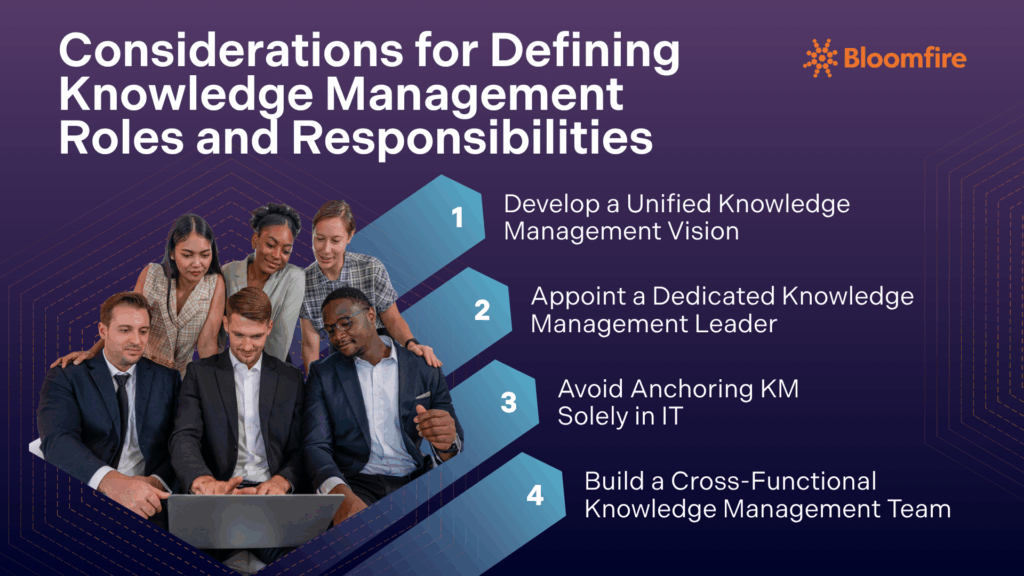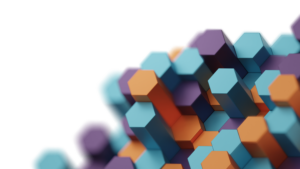Who is Responsible for Maintaining a Knowledge Management System?

In today’s business landscape, knowledge is one of the most valuable assets an organization can leverage. Successful leaders recognize that managing this knowledge can lead to benefits like cost savings, better decision-making, and enhanced employee engagement. Yet many organizations face challenges when it comes to ownership. Without a clear knowledge management (KM) team strategy, responsibility often falls through the cracks, causing department inefficiencies.
The responsibility for knowledge management tools comes down to a combination of dedicated KM roles and cross-departmental support teams. Most organizations need a dedicated Chief Knowledge Officer (CKO) or similar role.
In some cases, KM ownership is dispersed, leaving individual teams to define their own processes. This lack of cohesion can lead to information silos, a top barrier to effective knowledge management. To ensure success with knowledge management tools, it’s crucial to establish clarity around ownership, roles, and responsibilities.
Key Responsibilities in Maintaining a Knowledge Management System

When maintaining a KM system, it’s important to understand the responsibilities that come with it. This requires continuous strategic oversight, content management, and system administration to optimize knowledge sharing and organizational learning. Key responsibilities of maintaining a knowledge management system include:
- Developing comprehensive knowledge management strategies and policies that align directly with organizational goals and support sustained business performance.
- Managing and optimizing knowledge management systems and collaboration platforms to drive innovation, information sharing, and operational efficiency.
- Establishing structured methodologies for capturing, documenting, and storing both tacit and explicit knowledge to preserve institutional expertise and promote learning.
- Conducting regular reviews and updates of knowledge assets to maintain their relevance, accuracy, and accessibility across the organization.
- Defining specific roles and responsibilities within the knowledge management function to ensure accountability and continuous content stewardship.
- Monitoring the effectiveness of knowledge management through key performance indicators such as system utilization rates, knowledge contributions, and demonstrated business impact.
A well-maintained knowledge management system strengthens organizational intelligence by enabling employees to access and share critical information easily. Consistent responsibility, evaluation, and improvement of knowledge management tools and processes ensure that the system evolves alongside business goals.
Knowledge Management Team Structure Across Departments
An effective knowledge management (KM) framework aligns people, process, and technology across all departments. While individual departments often adapt KM to meet specific goals, the organization must maintain a unified strategy with clear governance to prevent fragmentation and ensure that knowledge remains a shared corporate asset. Some examples of different departments applying knowledge management include:
Customer support/customer experience
For customer-facing roles, KM empowers teams with quick access to up-to-date troubleshooting guides, FAQs, and best practices. A centralized knowledge base enables employees to resolve issues efficiently and consistently, enhancing both speed and accuracy. By supporting self-service tools and community-driven support, KM promotes customer autonomy, increases satisfaction, and reduces resolution times.
The KM team should ensure continuous content updates, relevance, and quality checks to maintain high standards of customer experience across all service channels. The goal here is to achieve speed and accuracy, enhance customer satisfaction, and decrease resolution times.
Insights/market research
For Insights teams, KM systems serve as the backbone for collecting, curating, and distributing research findings across the company. A unified knowledge repository eliminates silos by storing structured and unstructured data in a single searchable platform. Through this integration, KM fosters a culture of data-driven innovation and shared intelligence.
Deep indexing capabilities ensure that stakeholders at every level can quickly locate key findings and apply them to strategic and operational decisions. Knowledge management platforms can serve as centralized libraries where insights teams store structured and unstructured research in diverse formats such as slide decks, data visualizations, videos, and audio recordings.
Operations
Operation teams rely on KM tools to optimize efficiency, reduce errors, and promote process consistency. Centralized document repositories and workflow documentation ensure critical information, procedures, and best practices are easily accessible. This cohesive environment encourages collaboration, minimizes repetitive work, and sustains institutional knowledge that supports scalability and continuous improvement.
Operational KM teams are usually composed of process architects, documentation specialists, and systems managers. Process architects map operational workflows and translate them into standardized digital templates. Documentation specialists maintain repositories, ensuring procedural clarity and compliance. Systems managers oversee automation tools and synchronize data across platforms to ensure operational information remains up-to-date and auditable. This structure reinforces process integrity and allows the organization to adapt rapidly to market or structural changes.
Strategy
At the strategic level, KM acts as the framework that integrates departmental knowledge into a unified enterprise asset. Through structured governance, standardized taxonomies, and cross-departmental collaboration, KM turns individual expertise into collective intelligence. This holistic approach enhances innovation, risk management, and long-term adaptability. A dedicated KM leadership team maintains alignment between departmental needs and enterprise-wide objectives, ensuring that knowledge remains accessible, actionable, and continuously evolving.
Focusing solely on one department can lead to fragmented efforts. You need a comprehensive, enterprise-wide knowledge management strategy to drive long-term success that aligns with these varying goals. The person in charge of an organization’s knowledge must ensure that the strategy accounts for the needs of all departments.
Leveraging AI to Simplify Knowledge Management
Maintaining a knowledge management system has traditionally meant content audits, manual tagging, and version control headaches. But AI is transforming that reality.
Instead of relying solely on human teams to police every piece of content, AI now helps knowledge managers keep systems healthy automatically. It identifies outdated, duplicate, or conflicting material before employees even flag it and suggests updates or archiving actions based on usage patterns. Intelligent indexing and tagging ensure new content is categorized properly without the administrative lift.
Implementing AI within a KM system does not replace knowledge managers—it empowers them. By automating repetitive upkeep tasks, AI frees curators and admins to focus on higher-value work: verifying accuracy, refining structure, and engaging contributors. The result is a living, self-healing knowledge base that stays clean, trusted, and ready to deliver accurate information when teams need it most.
Over time, AI transforms knowledge maintenance from a reactive chore into a proactive, ongoing process that preserves institutional memory, reduces content decay, and strengthens confidence in search results.
Key Considerations for Defining Knowledge Management Roles and Responsibilities

Only 1 in 4 organizations has clear ownership for content governance across systems, so who is the director of knowledge management? Ultimately, there’s not one right answer, as the responsibility of knowledge management will likely look a little different in every organization. However, there are a few common considerations to keep in mind when developing the right structure for your company.
1. Develop a Unified Vision of Knowledge Management
A common mistake is developing disjointed KM objectives strictly based on departmental needs. Instead, craft a shared vision of knowledge management success that spans the entire organization. This unified vision allows employees across departments to understand the overall goals of the knowledge management service, how it benefits them, and how it contributes to the organization’s success.
By unifying knowledge management at every level, you encourage knowledge sharing, empower employees, and improve standard workflows. Departments align with a common strategy, fostering a more efficient, collaborative, and innovative workplace where knowledge flows freely and is applied effectively.
2. Appoint a Dedicated Knowledge Management Leader
While not all organizations have the luxury of appointing a Chief Knowledge Officer (CKO), it’s important to create a leadership role dedicated explicitly to knowledge management. A CKO (or a similar role) ensures that knowledge management initiatives receive the attention they deserve and aren’t sidelined by other priorities. This individual will promote KM across departments, ensuring that technology, processes, and people work together toward shared knowledge goals.
Ideally, they should be at a senior level and capable of influencing cross-departmental collaboration. This leadership role aligns initiatives with business priorities, fostering a collaborative workplace culture, and ensuring operational excellence in managing intellectual assets, maximizing the value of knowledge management to drive organizational performance and innovation.
3. Avoid Anchoring KM Solely in IT
It’s tempting to assign KM responsibility to the IT team since they often manage the platform itself. However, KM is about more than just technology—it’s about people and processes. While IT will be crucial in setting up and maintaining the technology infrastructure, the day-to-day success of your KM efforts hinges on a cross-functional team. This team should ensure that content governance, knowledge-sharing processes, and employee engagement align with business objectives.
The IT team should work closely with other departments to ensure the KM platform supports a cohesive strategy rather than simply managing it as a tech asset. This collaboration helps align the platform with broader business objectives, enabling it to become an integral part of organizational growth, innovation, and operational efficiency rather than just a standalone technical tool. When employees actively share and refine knowledge across teams, knowledge management evolves into Enterprise Intelligence—the point where information doesn’t just live in systems but drives decisions in real time.
4. Build a Cross-Functional Knowledge Management Team
Knowledge management impacts every department, so having a cross-functional team to drive the strategy forward is essential. While you don’t need every department represented, include key stakeholders who can advocate for the initiative and help guide the company toward its KM goals.
The members of this team should serve as champions in their respective departments, promoting knowledge sharing, encouraging best practices, and ensuring that the KM strategy is being effectively implemented at every level. They bridge the gap between the central KM team and frontline employees, facilitating feedback loops that help continuously refine and tailor knowledge initiatives to meet evolving departmental needs and challenges.
How Enterprise Intelligence is a Framework for Distributed Responsibility
Enterprise Intelligence is achieved when an organization effectively manages the flow of knowledge in a smart, automated manner, ensuring that insights are surfaced, refined, and applied in real-time. Teams applying the five principles of Enterprise Intelligence reduce the burden on individual owners by automating audit triggers, surfacing outdated knowledge, and routing updates to the right experts, enabling subject matter experts across business units to apply relevant knowledge to their specific contexts.
Support and enablement teams using Enterprise Intelligence frameworks reduce outdated content by 53% within six months. The unified model strikes a balance between autonomy and organizational oversight, promoting the capture of richer tacit knowledge, faster adaptability, and enhanced collaboration across large, complex organizations.
This distributed responsibility structure drives company-wide engagement, accountability, and alignment with strategic goals, making knowledge management both scalable and impactful. Achieving Enterprise Intelligence enables organizations to harness collective intelligence, accelerate innovation, and maintain agility in a rapidly changing business environment.
Frequently Asked Questions
Why is a cross-functional team essential for knowledge management?
A cross-functional team is important because it brings together professionals from different departments and expertise, enabling the sharing of diverse knowledge essential for problem-solving and innovation. This collaboration breaks down knowledge silos, enhances communication, and ensures that valuable insights from various functions are captured and accessible. By working together toward shared goals, cross-functional teams improve decision-making and accelerate project delivery, fostering a more cohesive knowledge environment.
How does Enterprise Intelligence prevent knowledge loss?
Tools used in Enterprise Intelligence, especially those leveraging AI, help capture and preserve critical institutional knowledge by transcribing key meetings, creating searchable knowledge bases, and providing Q&A chat features that simulate the availability of departing employees. This technology ensures continuity by making expertise accessible to remaining and new employees, reducing the risk of knowledge loss during workforce transitions. It also speeds up onboarding and maintains organizational memory, thus supporting business resilience.
Why is having a unified knowledge management vision important?
A unified knowledge management vision is vital, as it aligns organizational efforts to capture, organize, and share information cohesively across departments and systems. This alignment ensures consistent access to critical insights and supports faster decision-making and collaboration. Unified vision transforms knowledge from fragmented data into a strategic asset that drives innovation, productivity, and competitive advantage.
How do you measure the success of a knowledge management program?
Success is measured through key performance indicators (KPIs) aligned with the program’s objectives, like knowledge usage, accessibility, and contribution rates, which reflect employee engagement with the knowledge base. Additional metrics include time to resolve issues, customer satisfaction, and improvements in training and problem-solving efficiency. Combining quantitative data with qualitative feedback provides a comprehensive view of the KM program’s effectiveness and impact on organizational goals.
What challenges could organizations face without clear KM ownership?
Without clear ownership of knowledge management, organizations risk cluttered, outdated, and unreliable knowledge bases, as no one is accountable for updating or maintaining content. This can lead to decreased trust in knowledge resources, inefficient information retrieval, and potential loss of critical institutional knowledge. Lack of designated responsibility also hinders enforcement of standards and regular review processes, undermining the overall effectiveness of the KM system.
The Role of Leadership in Knowledge Management Success
Effective management of a knowledge management (KM) system depends on defined ownership and disciplined oversight. A KM system requires a dedicated team structure, led by a knowledge manager or a similar role, to maintain its reliability, scalability, and accessibility across all departments. This leadership is responsible for shaping the KM strategy, establishing clear processes for knowledge capture and validation, and ensuring the system evolves to meet organizational needs. By integrating automation, AI tools, and cross-departmental collaboration, managers can prevent information silos and align knowledge practices with overarching business objectives.
When managed effectively, a knowledge management system becomes a catalyst for Enterprise Intelligence. A well-structured platform like Bloomfire enhances operational efficiency, empowers informed decision-making, and fosters a culture of knowledge sharing. Organizations that continuously refine their KM systems through governance, training, and optimization position themselves for innovation, agility, and sustained competitive advantage.
This post was originally published in September 2022 and was most recently updated in November 2025.
Evolve Your Knowledge Management
Learn how Bloomfire can improve your KM to achieve Enterprise Intelligence
Download the Toolkit

How to Improve Customer Service in Call Centers: 21 Ways to Enhance Contact Center Experience

Innovative Ways Companies Are Using Knowledge Management

How to Implement a Knowledge Check in 6 Steps

Estimate the Value of Your Knowledge Assets
Use this calculator to see how enterprise intelligence can impact your bottom line. Choose areas of focus, and see tailored calculations that will give you a tangible ROI.

Take a self guided Tour
See Bloomfire in action across several potential configurations. Imagine the potential of your team when they stop searching and start finding critical knowledge.